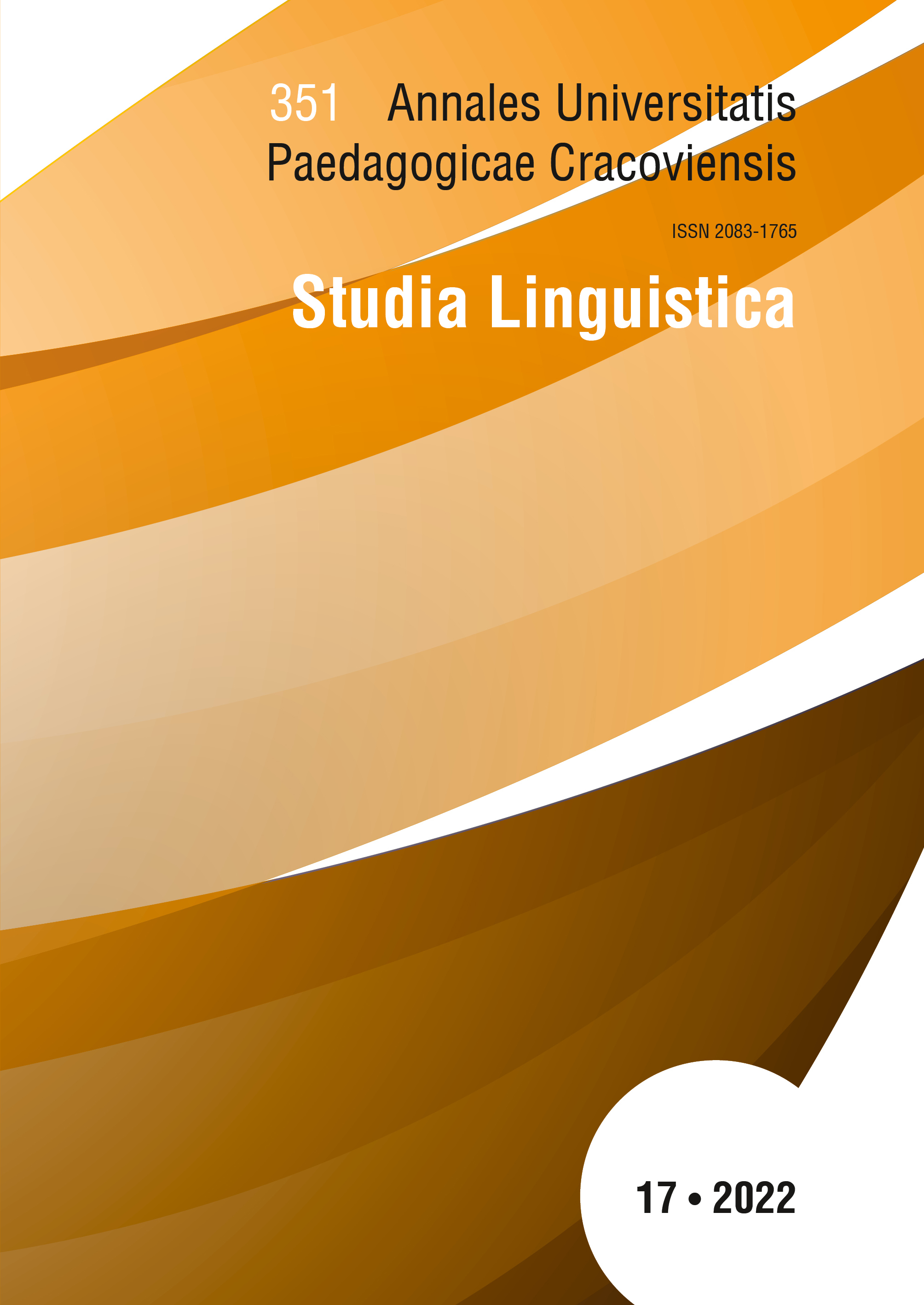Nineteenth century travel impressions from Italy in the perspective of a quantitative analysis of lexis in relation to the linguistic image of the world (on the example of Listy z podróży po Włoszech by Konstanty Gaszyński)
Main Article Content
Abstract
The article aims to recreate the tourist view based on the observation of the lexical layer of texts in quantitative terms. The subject of the research is the most frequent lexis excerpted in the form of an frequency list from Listy z podróży po Włoszech by Konstanty Gaszyński. The collected material consists of 300 words. The most common vocabulary was grouped into 9 semantic-lexical circles and analyzed using the research tools of cultural linguistics. The research has indicated that it is possible to reconstruct, on the basis of the analysis of the most common lexis, both the points of view in the texts and the correlated profiles of the Italian space.
Downloads
Article Details

This work is licensed under a Creative Commons Attribution-NonCommercial-NoDerivatives 4.0 International License.
Author, submitting a text to the editorial board of the journal “Annales Universitatis Paedagogicae Cracoviensis. Studia Linguistica", certifies that the content of the article has not been published so far and that the work does not violate in any way the copyright or related rights of other person, as well as other rights of third parties, and that no one's rights to the work (or any part thereof) have been missed. After signing the contract, the property rights to the published materials are transferred to the Scientific Publisher of the University of the National Education Commission, Krakow.
“Annales Universitatis Paedagogicae Cracoviensis. Studia Linguistica” is an open access journal, and all its content is made available free of charge to users and institutions under the Creative Commons CC-BY-NC-ND 4.0 license (attribution, non-commercial use, no derivative works). Under this license, the authors agree that their work may be lawfully reused for any purpose, except for commercial purposes, without the prior consent of the author or publisher. Everyone can read, download, copy, print, distribute and process these works, provided that the author's marking and the original publication place are correct. Published texts may not be used to create derivative works (e.g. to translate and publish in another language without the consent of the publisher). This is in line with the BOAI (Budapest Open Access Initiative) definition. "Studia Linguistica" does not charge for submitting or processing articles.
References
Anusiewicz J., 1994, Lingwistyka kulturowa. Zarys problematyki, Wrocław.
Google Scholar
Assmann A., 2019, Między historią a pamięcią. Antologia, przeł. M. Saryusz-Wolska, Warszawa.
Google Scholar
Bartmiński J., 1988, Kryteria ilościowe w badaniu stereotypów językowych, „Biuletyn Polskiego Towarzystwa Językoznawczego” XLI, s. 91–104.
Google Scholar
Bartmiński J., 1999, Punkt widzenia, perspektywa, językowy obraz świata, [w:] Językowy obraz świata, red. J. Bartmiński, Lublin, s. 103–120.
Google Scholar
Burkot S., 1988, Polskie podróżopisarstwo romantyczne, Warszawa.
Google Scholar
Czermińska M., 2003, „Punkt widzenia” jako kategoria antropologiczna i narracyjna w prozie niefikcjonalnej, „Teksty Drugie” 2–3, s. 11–27.
Google Scholar
Duda B., 2018, Miasto w świecie dyskursów, Katowice.
Google Scholar
Duggan C., 2009, Historia Włoch, przeł. J. Urban, Wrocław.
Google Scholar
Hammerl R., Sambor J., 1990, Statystyka dla językoznawców, Warszawa.
Google Scholar
Kozłowska A., 2009, Problemy z idiolektem, [w:] Język pisarzy jako problem lingwistyki, t. 2, red. T. Korpysz, A. Kozłowska, Warszawa, s. 111–131.
Google Scholar
Lyszczyna J., 2004, Konstantego Gaszyńskiego „Listy z podróży po Włoszech”, [w:] Wokół reportażu podróżniczego, red. E. Malinowska, D. Rott, A. Budzyńska-Daca, Katowice, s. 107–114.
Google Scholar
Maryl M., Piasecki M., Walkowiak T., 2018, Literary Exploration Machine A Web-Based Application for Textual Scholars.
Google Scholar
Mayenowa M.R., 1967, O matematyzacji lingwistyki, „Podstawowe problemy współczesnej techniki” XII, s. 135–162.
Google Scholar
Pawlikowska A., 2012, Zastosowanie metod językoznawstwa korpusowego i lingwistyki kwantytatywnej w analizie dyskursu, „Oblicza Komunikacji” 5, s. 111–125.
Google Scholar
Pawłowski A., 1999, Metodologiczne podstawy wykorzystania słowników frekwencyjnych w badaniu językowego obrazu świata, [w:] Przeszłość w językowym obrazie świata, red. A. Pajdzińska, P. Krzyżanowski, Lublin, s. 81–100.
Google Scholar
Pawłowski A., 2001, Metody kwantytatywne w sekwencyjnej analizie tekstu, Warszawa.
Google Scholar
Pawłowski A., 2003, Lingwistyka korpusowa — perspektywy i zagrożenia, „Polonica” XXII–XXIII, s. 19–32.
Google Scholar
Pietrzak M., 2020, Ze starego do nowego świata. Obraz miasta w Listach z podróży do Ameryki Henryka Sienkiewicza, „Poznańskie Studia Polonistyczne. Seria Językoznawcza” 27 (47), s. 129–149.
Google Scholar
Pisarek W., 1972, Frekwencja wyrazów w prasie: wiadomości, komentarze, reportaże. Kraków.
Google Scholar
Podemski K., 2005, Socjologia podróży, Poznań.
Google Scholar
Sambor J., 1988, Lingwistyka kwantytatywna – stan badań i perspektywy rozwoju, „Biuletyn Polskiego Towarzystwa Językoznawczego” XLI, s. 46–67.
Google Scholar
Suchenek R., 2004, Semantyka czasowników widzenia i patrzenia, „Linguistica Bidgostiana” 1, s. 159–166.
Google Scholar
Ulidis M., 2013, Blog a językowy obraz świata partii politycznej. Analiza kwantytatywno-korpusowa na przykładzie komunikacji Platformy Obywatelskiej, „Nowe Media” 4, s. 111–136.
Google Scholar
Witosz B., 2007, Gatunki podróżnicze w typologicznym ujęciu genologii lingwistycznej, [w:] Wokół reportażu podróżniczego, t. 2, red. D. Rott, Katowice, s. 11–30.
Google Scholar
Lzp – Gaszyński K., 1853, Listy z podróży po Włoszech, Lipsk.
Google Scholar
STL – Słownik terminów literackich, red. J. Sławiński, Wrocław 1998.
Google Scholar
SW – Słownik języka polskiego, red. J. Karłowicz, A. Kryński, W. Niedźwiedzki, t. 1–8, Warszawa 1900–1927 (słownik warszawski).
Google Scholar
SWil – Słownik języka polskiego, t. 1–2, Wilno 1861, https://eswil.ijp.pan.pl/ (dostęp 22.12.2021) (słownik wileński).
Google Scholar
WSJP PAN – Wielki słownik języka polskiego PAN, red. P. Żmigrodzki, https://wsjp.pl/ (dostęp 22.12.2021).
Google Scholar

